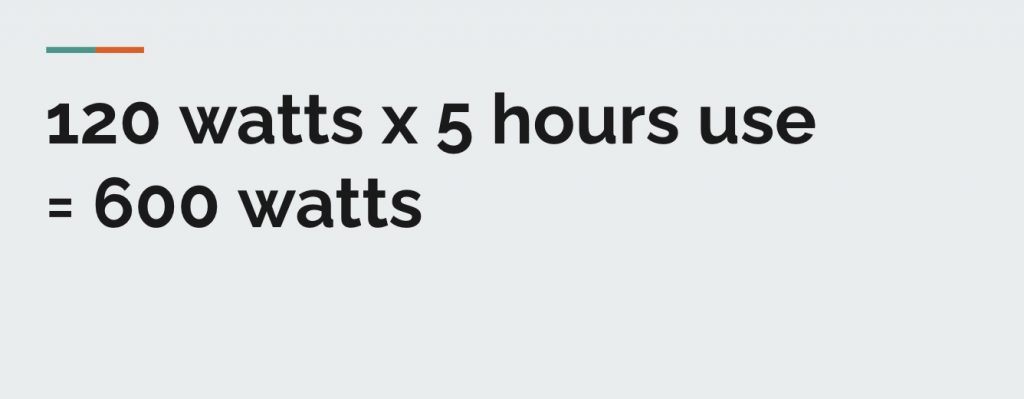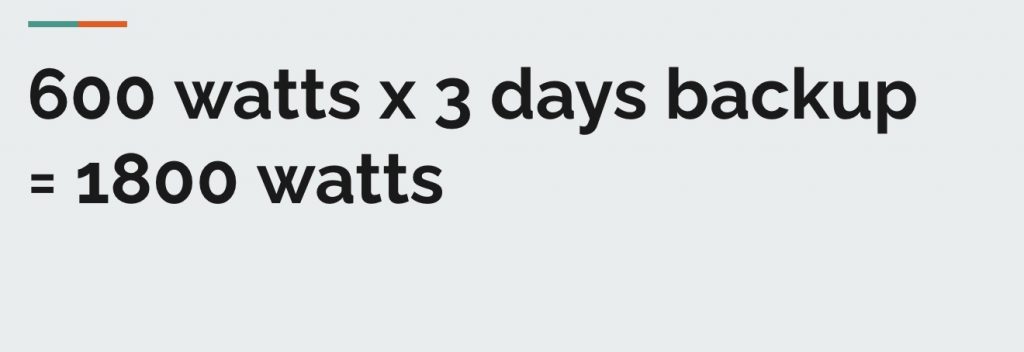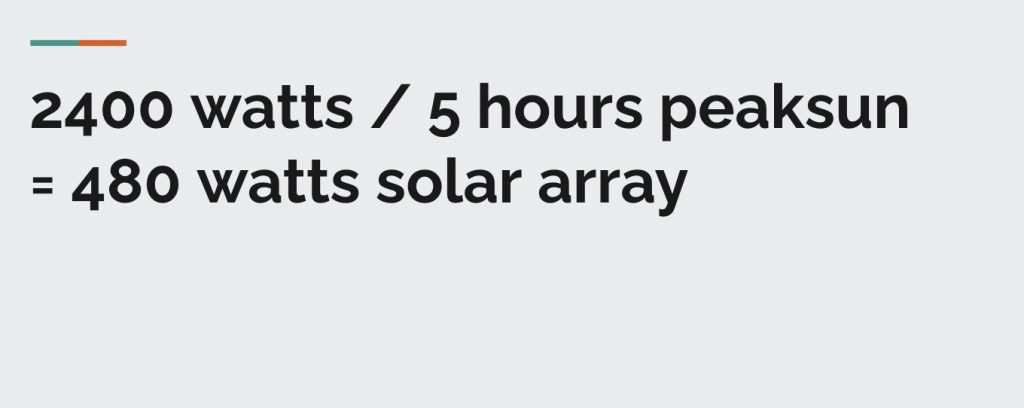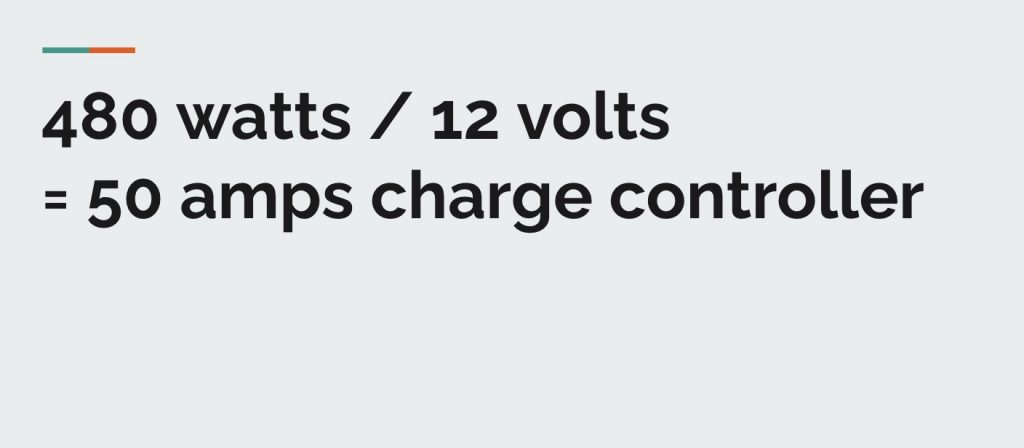This online tool will teach you how to size a solar power system in the simplest way possible.
First, we give you a tool that helps you size your solar system by entering your energy load. After you provide all appliances’ watt and usage hours, the tool will calculate and suggests:
- What size battery do you need
- What size solar array will charge that battery.
- What size charge controller do you need
Then, we will give you a simple example by providing a certain watt-hour load. We’re going to figure out what size battery we need with a certain amount of days of autonomy or how many days of backup, and we’re going to figure out what size solar array will charge that battery in a decent amount of time.
Contents
Solar System Sizing Tool
To use the tool on mobile, you can scroll the tool below horizontally or switch to landscape mode.

Your daily total load is: 0 Watts a day
Your total load for 2 days backup is: 0 Watts
0 amps
Your solar system size should be:
Choose the Best Products for Solar System
In the section below, we will help you pick the best products for your solar system.
Solar System array design
Because solar panels are cheap, you might want to pump your system to 0 watts array so then you can get higher power generated during sunny days.
0 watts solar array will need 0 solar panels (600-watt type). The Renogy 600W is the best choice among our reviews for solar panels.
Choose the right battery
To store watts, you can use 0 of 24V-200ah Lithium Battery
Choose the right charge controller
Best 0-amps charge controller is Renogy Solar charge controller
Sizing a solar power system in the simplest example
Now I will use the solar system sizing tool above to make a simple sample.
Let’s say we have a fan that takes 120 watts, and you want to run it for five hours a day. All you have to do is multiply the consumption by the hours you use it.

Sizing solar battery
120 multiplied by five is 600, so we need a battery that can supply 600 watt-hours for our given load daily.
But we want to have enough time for backup or days of autonomy. A good figure is three to five days of autonomy. This means that if you have a cloudy or rainy day, you will have enough backup power to power your loads during that duration of the reduced power output of your solar system.
All you do is multiply this by three, so 600 times three is 1800 watt-hours. 1800 watt-hours is the total size of our battery.

But this 1800 watt-hours is the usable size. Understand that if you have a thousand watt-hour lithium battery, it will deliver 1000 watt-hours. Typically, the recommendation for lead acid batteries is 50% of the discharge, meaning you can only use half of the battery’s rated capacity. So if you have a thousand watt-hour lead acid battery, you can only use 500 watt-hours.
In general, a battle-born lithium iron phosphate battery will deliver 1200 watt-hours. So you could say that you need at least two of them to fulfill this system to power our laptop consistently without any problems. And with three days of backup will take two battle-born batteries, or you could say they will take 400 amp hours of lead acid batteries at a standard depth of discharge of 50 percent.
And you’ll notice that two battle-born batteries will deliver 2400 watt-hours, so typically, you want to round the number up also. You can’t stick with one battery, so you have to round the number up if you want to fulfill the low requirement with three days of autonomy.
You don’t need this large battery if you live in a very sunny location. You could probably get by with this small like some places such as Las Vegas. You could easily power this load with a 600Wh battery because these locations never need that many days of backup power. Even on the bad days, you will still be able to generate enough power to power this load. So it depends on your local weather conditions and other factors such as your latitude.
So for this laptop to run for five hours a day with three days of backup, you want two battle-born batteries or 100 amp power sealed lead-acid batteries.
Sizing your solar array
We need to figure out what size solar array will charge these two battle-born batteries in one day.
In our example, we need to be able to charge 2400 watt hours in one day, so how do we determine the size of the solar array?
The recommended figure in the United States is five hours of good sunshine. If you are using an MPPT and standard test conditions solar panels, all you need to do is take the size of your battery in watt-hours and divide it by five because overall most of the United States, you will get five hours of sunshine, and that’s how much power in watts it will be required to charge up this battery in one day.
So 2400 divided by five is 480 watts, so we need an array that is 480 watts in size, and because solar panels are cheap, you’re can bump this up to 600 watts, and that’s a pretty simple recommendation to belabor batteries or for lead acid batteries it is a 600-watt array.

Sizing solar charge controller
Now that we know how to size your batteries and solar array. We’ll figure out what size solar charge controller we need to charge our solar battery.
To size the solar charge controller, you can take your solar array size and divide it by the battery voltage.
In our example, we have a 12 volt 2400 watt hour battery with a 600-watt solar array. So we just take 600 and divide it by 12. That will give us 50, and this is the amps required by our solar charge controller to be able to support this solar panel array at this voltage.

Because the wattage divided by the voltage will give you the amperage, this is the output rating. If you are sizing a solar charge controller for a system, you typically want to make it larger than necessary and typically in 20 percent increments at the output size. So I would be going with a 60 amp controller, and that’s also for efficiency reasons.
So, a 60 amp controller will support our solar system with a 600-watt solar panel array and a 12-volt battery.
Additional info
Because we have a 2400Wh battery, we’re not using the laptop, and want to power the microwave for 30 minutes a day. The microwave uses 1000 watts continuously, meaning it will use 500 watt-hours in 30 minutes.
What we can say is that this battery can easily support our microwave and laptop depending on how we use it and also depending on how many days of backup we’ll determine our use.
If it’s sunny every day for the next week, you can use much more power than our recommended. So in this instance, with this large battery, we have a lot of power to work with if it’s sunny outside. If it’s cold and cloudy, you can’t use the bigger appliances, and you need to reduce your load to have that full three days of backup.
However, for most people, this size system with a 2400Wh battery in a 600W solar array will be able to power a lot of good stuff, and when it comes to solar, you want to make it as big as possible.
Solar panel arrays are cheap, solar charge controllers are cheap, but batteries are very dreadfully expensive, unfortunately. You can now give solar panels for $0.50 a watt or cheaper. You can even buy Sun Power Cells for dirt cheap from San Tan solar. It means that you can bump up as much as possible.
You would cut this 2400Wh battery in half and have like a tiny battery, and you have such a large solar panel array that I could reach Origen very quickly, and for this size system, this 600-watt array could charge your battery in less than a day.
That’s typically good for it, like a lead acid battery. You need to cycle it once a day or keep it at a high state of charge at the end of every day so that it doesn’t have too much degradation.
If a lead-acid battery is kept at a low state of charge for a prolonged duration, you will have increased internal damage to that battery, so you want to keep it cycled once a day and then a high save charge for as long as possible.
Increase the voltage of charge controller to reduce the average cost
In our example, this is super simple math that anybody can do now. Let’s make this more fun by taking the 600-watt array and dividing it by 24, and figuring out what controller size we need.
So 600 divided by 24 is 25, so we need a 25 amp controller that can handle a 24-volt battery.
Now, why did I do that? Think about how much cheaper a 25 amp controller is than a 50 or 60 amp controller? Of course, we would want to bump the controller up to 30 amps, but you’re getting huge cost savings by using the 24-volt battery, and this is why you can save literally hundreds and hundreds of dollars by bumping up the voltage of your battery to 24 volts.
We have another article that covers the pros and cons, how to do that, and how to use converters so you can still use 12-volt appliances but keep that in mind when you have a large array in a large charge controller and you bump up the battery voltage, it will decrease the cost of the system substantially.
You will also substantially decrease the cost and wire with a higher voltage system. A large-load 12-volt system with this sized battery requires thick wiring, and copper is not cheap. If you’re pushing large loads and you have a 48-volt or 24-volt system, it will be a lot smaller and wire which means reduced cost, but again we have another article that goes much into deeper details on that topic.
If this article lost you and you don’t understand volts and amps, please check out my beginner tips. You need to read those or the beginner book that’s probably the easiest way to do it. Step by step, we show everything you need to know, making it very easy to understand.
Final thought
I hope you guys found this tool and example calculation useful. I thought it was fun coz I get these questions a lot, and it’s so simple if you know how large your load is and how long you want to power it for.
You can calculate any size system instantly. If you do not understand these watt-hours and watts, please check out the beginner stuff, it’s only a couple of equations it’s volts times amps equals watts, and once you know that you can mess with the division, you can calculate any size system grid tire off-grid it’s super simple.
Finally, I hope you guys found this tool and its sample of usage useful, and let me know what you guys think.